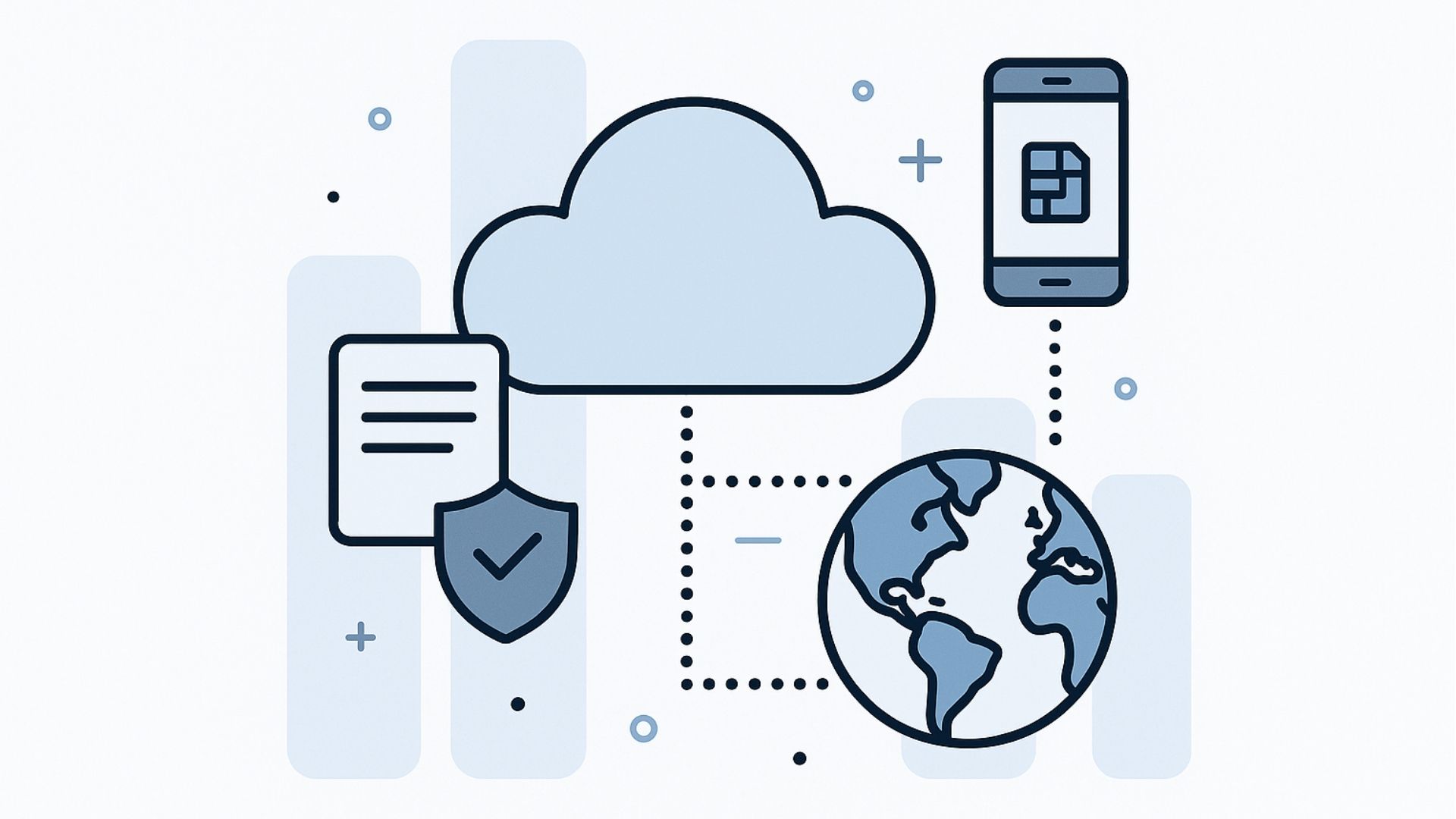Data Sovereignty Meets Global Mobility: How Enterprises Can Stay Safe
In an era of global workforces, cross-border data flows, and expanding enterprise connectivity, maintaining compliance with data sovereignty laws is both a challenge and a necessity. This in-depth guide explores how CIOs, CTOs, and compliance leaders can navigate global mobility without compromising control, security, or visibility. Learn how modern eSIM management and unified connectivity solutions like Voye Data Pool empower enterprises to balance agility with protection. From regulatory complexities to real-world governance frameworks, this piece provides practical strategies for achieving secure, compliant, and scalable mobility in the borderless digital age.

The New Face of Data in Motion
The modern enterprise is no longer bound by geography.
From remote engineers in Singapore to sales executives flying between London and Dubai, corporate data now moves as dynamically as the people who create it. Every device, every connection, and every digital handshake carries fragments of sensitive business information across jurisdictions.
This global fluidity presents both opportunity and risk.
While global mobility accelerates innovation, it also fragments compliance responsibilities. Data sovereignty—the principle that information is subject to the laws of the country in which it’s stored—now collides head-on with enterprise mobility, where storage and transmission happen across borders, clouds, and networks.
For CIOs, CTOs, and compliance officers, this creates a fundamental question:
How can an organization remain globally connected yet locally compliant?
1. Understanding Data Sovereignty: The Foundation of Trust
Data sovereignty goes beyond storage location. It’s about control, accountability, and lawful governance of digital assets.
In simplest terms, data sovereignty ensures that information collected within a jurisdiction is handled according to that nation’s legal framework. Whether it’s the GDPR in Europe, CCPA in California, PDPA in Singapore, or India’s Digital Personal Data Protection Act, enterprises must know where data resides, who accesses it, and under what authority.
But as organizations embrace global operations, the concept of sovereignty becomes blurred. Cloud hosting, distributed edge computing, and mobile-first connectivity make it nearly impossible to contain data within a single border.
Why It Matters for Enterprises
- Compliance risk: Storing or transferring data in non-compliant regions can trigger legal penalties.
- Reputation impact: Breaches or violations of local data laws can damage customer trust.
- Operational disruption: Regulatory investigations or sanctions can halt business continuity.
Modern compliance demands visibility, traceability, and control—elements often lost when data roams freely.
2. The Mobility Challenge: Borderless Workforce, Bordered Laws
The corporate world has embraced hybrid work and global collaboration at an unprecedented scale.
Sales teams, consultants, and developers no longer operate within national boundaries. Yet, every mobile device they use—smartphone, tablet, or IoT sensor—creates a compliance footprint.
Global Mobility Meets Jurisdictional Complexity
Consider this:
A U.S.-based executive traveling to Germany connects to a local cellular network. The device transmits encrypted company data through European infrastructure, possibly even routing through third-party providers.
Legally, portions of that data fall under EU jurisdiction—even if the enterprise’s headquarters and servers remain in the U.S.
For CIOs and compliance leaders, this presents a paradox:
- The employee’s need for seamless connectivity directly conflicts with
- The organization’s responsibility for lawful data handling.
This is where traditional mobile connectivity models—reliant on physical SIMs and carrier-specific agreements—start to break down. They were never built for the fluid, multi-jurisdictional nature of modern enterprise mobility.
3. The Rise of eSIM and Its Role in Data Governance
eSIM technology has emerged as the silent enabler of global business.
It allows enterprises to digitally activate, manage, and switch between multiple carrier profiles without physical intervention. But more importantly, it introduces centralized visibility and control—the two pillars of compliance.
Enterprise eSIM Management: A Strategic Advantage
Unlike consumer-grade eSIMs, enterprise-grade solutions like Voye Data Pool integrate policy enforcement, analytics, and security governance directly into the connectivity layer.
Key benefits include:
- Centralized provisioning: Manage global connectivity from a single, secure platform.
- Policy-based routing: Enforce data residency rules by defining where and how devices connect.
- Granular monitoring: Track usage, device location, and compliance adherence in real-time.
- Scalable control: Add or revoke connectivity instantly across teams and regions.
In essence, eSIM transforms connectivity from a logistical task into a strategic compliance mechanism.
4. Data Sovereignty Risks in Global Connectivity
While mobility is essential, enterprises face significant challenges when data crosses borders:
A. Regulatory Fragmentation
Each country interprets data sovereignty differently.
For instance:
- EU’s GDPR mandates strict data localization and transfer rules.
- China’s CSL requires domestic storage of personal and critical information.
- Australia’s Privacy Act emphasizes cross-border transfer safeguards.
Enterprises operating globally must maintain multi-jurisdictional awareness—a task impossible without unified visibility.
B. Third-Party Network Exposure
When employees connect via roaming or public networks, their traffic often traverses multiple service providers. This introduces:
- Exposure to untrusted intermediaries
- Untraceable routing paths
- Difficulty ensuring compliance with end-to-end encryption policies
C. Shadow IT and Unmanaged Devices
Unmanaged personal devices pose a sovereignty nightmare. Without MDM integration or controlled connectivity, sensitive data might leave compliant environments without traceability.
D. Data Duplication and Cloud Replication
Cloud synchronization tools—while convenient—often replicate data across regions. CIOs must ensure data residency enforcement at both application and network levels.

Seamless eSIM Connectivity for Enterprises
Activate, manage, and scale eSIMs with ease.
5. Building a Framework for Data-Safe Mobility
Enterprise leaders must go beyond policy documentation and establish architecture-level safeguards that integrate compliance into mobility infrastructure.
Step 1: Map Data Flows
Conduct an end-to-end mapping of:
- Data sources (devices, applications, sensors)
- Transmission paths (cellular, Wi-Fi, VPN)
- Storage destinations (clouds, data centers)
- Legal touchpoints (jurisdictions involved)
This map becomes the blueprint for regulatory alignment.
Step 2: Classify Data Sensitivity
Categorize corporate data into tiers of sensitivity—financial, personal, operational, etc.—and assign residency and encryption standards accordingly.
Step 3: Implement Identity-Based Access
Adopt zero-trust architectures where connectivity privileges depend on user identity, device posture, and location context.
Step 4: Enforce Policy at the Connectivity Layer
This is where Voye Data Pool’s enterprise eSIM platform becomes instrumental. By embedding compliance policies into the very fabric of connectivity, organizations can:
- Restrict routing through non-compliant regions
- Monitor real-time activity
- Segment connectivity by department or geography
Step 5: Establish Auditable Records
ata sovereignty is not just about control—it’s about proving control. Audit trails, usage logs, and reporting dashboards help demonstrate compliance to regulators and auditors alike.
6. eSIM as a Compliance Enabler
Beyond operational convenience, eSIM technology offers unique governance advantages that align perfectly with data sovereignty principles.
A. Location-Aware Activation
Enterprises can define where an eSIM profile can be activated or used. This ensures that data sessions never originate from restricted zones.
B. Secure Provisioning Channels
Profiles are distributed through encrypted, tamper-proof mechanisms, eliminating risks of SIM cloning or interception.
C. Lifecycle Management
From activation to decommissioning, every connectivity event is timestamped and recorded, creating a compliance-grade audit trail.
D. Unified Global Visibility
Enterprises can finally answer questions like:
- “Which devices are transmitting from non-compliant regions?”
- “What percentage of mobile data is routed through foreign jurisdictions?”
- “Which users are exceeding cross-border transfer thresholds?”
Visibility transforms compliance from reactive firefighting to proactive governance.
7. The Role of Encryption, VPNs, and Private APNs
While eSIM provides the foundational control layer, additional technologies reinforce sovereignty:
- Encryption: End-to-end data encryption protects information in transit and at rest, ensuring data remains unreadable even if intercepted.
- VPNs: Secure tunneling provides confidentiality for roaming employees, though routing through non-compliant regions can still introduce legal complexity.
- Private APNs: Custom access point names restrict connectivity to enterprise-controlled gateways, reducing exposure to public networks.
Integrating these with eSIM-based routing gives enterprises a multi-layered defense—aligning performance, privacy, and compliance.
8. Data Localization vs. Data Accessibility: Finding the Balance
Enterprises often struggle between keeping data local and keeping operations agile.
Full data localization can slow collaboration and innovation, while excessive flexibility increases risk.
CIOs must craft a hybrid model:
- Critical personal and financial data stay local.
- Operational, anonymized, or aggregated data flows globally under controlled conditions.
This balance requires technology-led enforcement, not manual processes. With platforms like Voye Data Pool, enterprises can configure connectivity rules that automatically adapt to geography, team, and data type.
9. Governance in Motion: Real-World Scenarios
Case Example 1: Global Consulting Firm
A multinational consultancy deploys Voye Data Pool eSIMs for its consultants across 40 countries.
Result:
- All connectivity logs are centralized.
- Data routing complies with regional laws.
- Mobility costs drop 35% while compliance confidence rises.
Case Example 2: Industrial IoT Manufacturer
IoT devices across Asia and Europe transmit production metrics to a unified dashboard. By using region-specific eSIM profiles, data remains locally compliant while centrally analyzable through anonymized channels.
Case Example 3: Financial Enterprise
A bank’s traveling executives use Voye-managed eSIMs that automatically disable in high-risk jurisdictions, maintaining both compliance integrity and network resilience.
10. Measuring Data Sovereignty Success
True compliance isn’t static—it evolves with regulation.
Enterprises should define measurable outcomes such as:
- 100% visibility of mobile and IoT connections
- Zero unauthorized cross-border transfers
- Automated compliance reporting
- Reduced data-handling risk score across regions
eSIM-powered platforms make these outcomes auditable, transparent, and repeatable.
11. The Future: Digital Borders in a Borderless World
As regulators tighten control and enterprises expand reach, digital sovereignty will become a competitive differentiator.
The next frontier involves:
- AI-driven compliance orchestration—detecting and adjusting data flows in real-time.
- Edge-based processing—keeping sensitive computation close to origin.
- Blockchain-based audit trails—for immutable proof of compliance.
Enterprises that master sovereignty within mobility will define the next decade of trusted global operations.
Conclusion: Turning Compliance Into Competitive Advantage
Data sovereignty and global mobility are not opposing forces—they’re complementary imperatives of the modern enterprise.
The leaders who recognize this will turn regulation into resilience, compliance into confidence, and connectivity into a catalyst for secure growth.
By adopting intelligent, centralized solutions like Voye Data Pool, enterprises can finally achieve what was once thought impossible:
freedom to operate anywhere, with control everywhere.

Seamless eSIM Connectivity for Enterprises
Activate, manage, and scale eSIMs with ease.



 8 min read
8 min read





